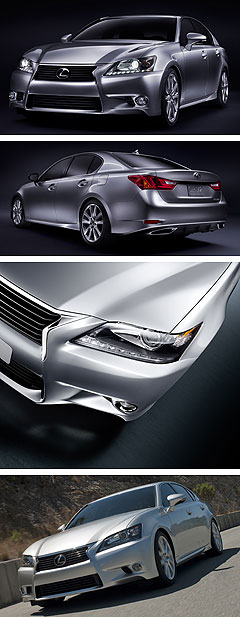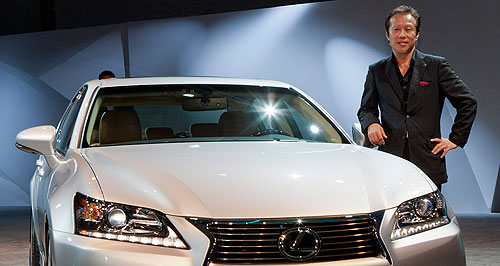Make / Model Search
Future models - Lexus - GSV10 F version, plug-in hybrid Lexus GS chief’s wish-listGS directions: The Lexus GS chief engineer Yoshihiko Kanamori at the Pebble Beach unveiling. Lexus chief engineer weighs up V10 super-sedan and plug-in hybrid for new GS range19 Aug 2011 By RON HAMMERTON in PEBBLE BEACH THE chief engineer for the new hard-edged Lexus GS has hinted that a plug-in hybrid version of the mid-sized luxury car is on the cards – and maybe even a thumping ‘F’ model powered by a modified version of the 412kW 4.8-litre V10 from the Lexus LFA supercar. Yoshihiko Kanamori, a former Toyota body engineer who headed the development on the 2007 Corolla before being asked to head up the GS project, said Lexus had no plans for the V10 project, but conceded that it was technically feasible to fit the engine into the new GS. And proving he has thought about it, he went on to say the engine would need to be detuned to place more emphasis on torque than power. “But I am not sure,” he said. “We have some plan for the next F model.” A Lexus insider pointed out that the hot-shot IS F sports sedan started out as a ‘skunkworks’ after-hours project, and that a V10 GS F could start the same way now that the V8-powered GS will not carry over with the new-generation model when it hits showrooms in the first half of 2012. Speaking at today’s reveal of the all-new GS350 at Pebble Beach, California, Mr Kanamori was more forthcoming about plans for a plug-in hybrid, saying: “We should be starting to think about it in the current model life.”  The standard hybrid version, the GS450h, is set to be unveiled at the Frankfurt motor show in September, with Toyota also confirming in recent days that the production version of its plug-in hybrid Prius will be shown at Frankfurt ahead of its launch in Japan, Europe, North America and other markets next year. (An Australian introduction is still under evaluation.)Mr Kanamori said his team were also preparing the GS F Sport enhancement models that will appear later in the year. The standard hybrid version, the GS450h, is set to be unveiled at the Frankfurt motor show in September, with Toyota also confirming in recent days that the production version of its plug-in hybrid Prius will be shown at Frankfurt ahead of its launch in Japan, Europe, North America and other markets next year. (An Australian introduction is still under evaluation.)Mr Kanamori said his team were also preparing the GS F Sport enhancement models that will appear later in the year.A glimpse of the GS350 F Sport shown in a presentation slide at today’s launch revealed that it will get a more aggressive version of the new-look ‘spindle grille’ front fascia, including a partly blacked out bar across the centre of the main opening instead of the body-coloured bar of the new GS350. Some critics have suggested the Lexus designers should have adopted the full grille treatment of the concept car precursor to the GS, the LF-Gh. That might yet be on the cards, not only in the F Sports variants of the ES350 and ES450h, but also in models due to arrive in the middle of the car’s lifespan. Mr Kanamori confirmed that move was being considered. Other Lexus executives said the higher-performance GS models in the pipeline would take on a more aggressive version of the front fascia, more like the original concept. Mr Kanamori said details of the hybrid GS450h would be given at the Frankfurt motor show, but indicated it would get more performance than the current version, saying it would outperform the current 255kW 4.6-litre V8 GS460 that can race from zero to 100km/h in 5.8 seconds. In comparison, the current GS450h combines a 3.5-litre V6 engine with a 650-volt electric motor for a combined 254kW of maximum power and can hit 100km/h in 5.9 seconds. Mr Kanamori said the performance potential from the hybrid system had caused him and his team to drop the V8 from the new range. He said another factor was confusion among customers as to which model was the top-end variant – a matter now put to rest. Mr Kanamori said the hybrid powertrain was one of the GS’s major strengths and points of difference from Lexus’ main rivals, which he named as “the three Germans”. But he said the latest GS added vehicle dynamics to that list of strengths, as the new GS could compete with the German mid-sized cars in that regard. Mr Kanamori said he was continuing with the GS project, putting the finishing touches to the production cars ahead of the early 2012 launch and working on other variants to come later. “I have to take care of this model,” he said. Mr Kanamori said that of all of the models in which he had been involved over his career – a list that includes the Toyota Cressida and Celica, as well as the Corolla and GS – he was most proud of the GS because of the high standards that had to be achieved. “Reaching those standards is very satisfying,” he said. Mr Kanamori said he did not have to compromise as much on the GS as on the Corolla, and had managed to reach all of his goals in the GS project. These goals included making the car more fun to drive, improving its dynamics and making it more spacious.  Read moreAll future models Alfa Romeo Alfa Romeo Abarth Abarth Alpine Alpine Alpina Alpina Audi Audi Aston Martin Aston Martin BMW BMW Bentley Bentley Chery Chery Brabham Brabham Chrysler Chrysler Chevrolet Chevrolet Cupra Cupra Citroen Citroen DS DS Dodge Dodge Fiat Fiat Ferrari Ferrari Foton Foton Ford Ford Great Wall Great Wall FPV FPV Haval Haval GWM GWM Honda Honda Holden Holden Hummer Hummer HSV HSV Infiniti Infiniti Hyundai Hyundai Jaguar Jaguar Isuzu Isuzu Kia Kia Jeep Jeep Land Rover Land Rover Lamborghini Lamborghini Lexus Lexus LDV LDV Mahindra Mahindra Lotus Lotus Mazda Mazda Maserati Maserati Mercedes-AMG Mercedes-AMG McLaren McLaren MG MG Mercedes-Benz Mercedes-Benz Mitsubishi Mitsubishi Mini Mini Opel Opel Nissan Nissan Peugeot Peugeot Pagani Pagani Proton Proton Porsche Porsche Renault Renault Ram Ram Rover Rover Rolls-Royce Rolls-Royce Skoda Skoda Saab Saab SsangYong SsangYong Smart Smart Suzuki Suzuki Subaru Subaru Toyota Toyota Tesla Tesla Volvo VolvoGS pricing
Motor industry news |
Click to shareLexus modelsResearch Lexus All future models Alfa Romeo Alfa Romeo Abarth Abarth Alpine Alpine Alpina Alpina Audi Audi Aston Martin Aston Martin BMW BMW Bentley Bentley Chery Chery Brabham Brabham Chrysler Chrysler Chevrolet Chevrolet Cupra Cupra Citroen Citroen DS DS Dodge Dodge Fiat Fiat Ferrari Ferrari Foton Foton Ford Ford Great Wall Great Wall FPV FPV Haval Haval GWM GWM Honda Honda Holden Holden Hummer Hummer HSV HSV Infiniti Infiniti Hyundai Hyundai Jaguar Jaguar Isuzu Isuzu Kia Kia Jeep Jeep Land Rover Land Rover Lamborghini Lamborghini Lexus Lexus LDV LDV Mahindra Mahindra Lotus Lotus Mazda Mazda Maserati Maserati Mercedes-AMG Mercedes-AMG McLaren McLaren MG MG Mercedes-Benz Mercedes-Benz Mitsubishi Mitsubishi Mini Mini Opel Opel Nissan Nissan Peugeot Peugeot Pagani Pagani Proton Proton Porsche Porsche Renault Renault Ram Ram Rover Rover Rolls-Royce Rolls-Royce Skoda Skoda Saab Saab SsangYong SsangYong Smart Smart Suzuki Suzuki Subaru Subaru Toyota Toyota Tesla Tesla Volvo VolvoGS pricing
Motor industry news |











Facebook Twitter Instagram